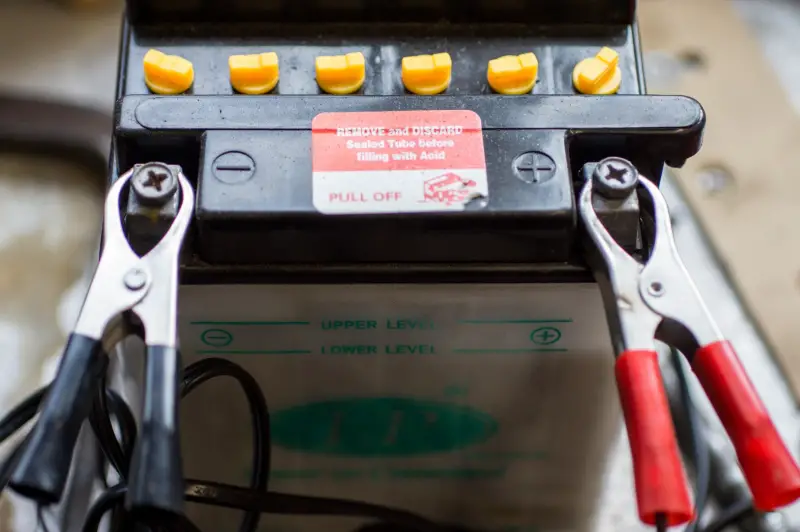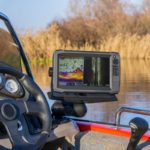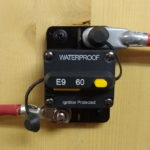When running a fish finder on your boat, the last thing you want to do is run your battery dead. Adding a separate battery for your fish finder can prevent you from being stranded.
Also, a separate battery for your fish finder can reduce electrical interference. When looking for different options, your primary concern is a 12-volt rating, usually 12.4 to 12.8 volts.
Additionally, you want to get a battery that will last because no one wants to waste their hard-earned money. So is essential to get a battery that can be discharged and recharged many times without damage.
In this article, we will answer some questions about a few different battery options and give you some information that will help you make the best choice for your situation.
Note: most links in this article are Amazon.com Affiliate links, see Affiliate Disclosure, thank you.
Will a Motorcycle Battery Run a Fish Finder?
You can run your fish finder with a motorcycle battery, but if your battery is not deep cycle or dual cycle, it can be damaged. For this reason, we recommend only using a traditional motorcycle battery when pairing it with a gas trolling motor with a charging system.
Most motorcycle batteries are cranking-type batteries that are designed to deliver high amperage in short bursts to start the motor, like car batteries. Typically, these batteries will be recharged rather quickly and not be run down, which is a shallow cycle.
A fish finder will be left on for an extended period, slowly draining the battery to as low as 50%; this is called a deep cycle. This can be problematic if your motorcycle battery is not intended for deep cycling. The typical result is a reduction in total battery cycles, aka battery life. Also, it can run your motorcycle battery too low and fail completely.
Traditionally, motorcycle batteries have been flooded lead acid batteries, but AGM and lithium have become more popular. Motorcycle batteries are roughly half the size of car batteries, but exact measurements may vary to fit each motorcycle.
Most motorcycle batteries are 12 volts and average 200 Cold-cranking amps with an average of 12 Amp hours. Many lithium motorcycle batteries are dual cycle, making them an excellent choice for fish finders and gas trolling motors with electric start.
Avoid 6-volt batteries because you will need two to get the proper voltage for your fish finder. In practice, we do not recommend flooded lead acid batteries in any boat that goes over five mph. However, motorcycle batteries are more spill resistant than car flooded lead acid batteries.
Keep in mind that you can find a lot of batteries that are more suited for beep cycle marine applications. We have an article on lightweight batteries that have been tested. You can also see our video for our favorite powerful, lightweight battery.
Will a Lawn Mower Battery Run a Fish Finder?
Lawn mower or lawn tractor batteries work great with fish finders. Many lawnmower batteries are sealed lead acid or AGM batteries that are deep cycle or dual power, making them perfect for running a fish finder and starting a small gas trolling motor.
While the lawn mower battery is meant for starting, designers know that a mower may sit in a garage for a month between uses. For that reason, a mower battery needs to be powerful and charge cycle capable.
It is not uncommon to see a mower battery that is 12-volt dual cycle AGM rated at 350 Cold Cranking Amps and 21 amp hours. These batteries have a slow discharge rate and can jump-start when low.
An AGM battery with a 21 amp hour rating will give the average user over 10 hours of fish finder run time for each charge. A better option for this type of battery is to connect your gas trolling motor and fish finder to the battery so you can charge it while you use it.
Almost all lawn mowers run on 12 volts, so finding a compatible battery should be easy. Remember that when looking at lithium battery options, amp hour ratings that are 50% lower are roughly the same as lead acid batteries. You can use 100% of the battery’s rated capacity with lithium batteries.
Will A Trolling Motor Battery Run a Fish Finder?
A trolling motor battery will easily run a fish finder. However, there is a list of pluses and minuses that you will need to consider before doing so.
First, most boat electronics are standard 12 volt, and the most common trolling motor voltage is 24 volt. You can definitely connect your electronics to one battery but over time, that will put your batteries out of balance.
Uneven usage of one battery in your bank can cause the entire bank to fail prematurely. A simple step-down converter can solve this issue, but other options are available.
Most Garmin devices have a volt range of 9 Vdc to 18 Vdc, but both edges could cause your device to perform unpredictably. Many hummingbird units are rated from 10.5 Vdc to 20 Vdc, basically 12-volt systems.
Second, if you power your fish finder with your trolling motor battery (or batteries), you will use Amp Hours that you might need for your trolling motor. A separate battery could be a better and cheaper option.
On the plus side, your trolling motor and fish finder will be separate for your starting battery, reducing the wear and risk of a dead battery when you need to start your main motor. Additionally, some main motor batteries are cranking or dual power type batteries.
Even dual power batteries do not perform as well as deep cycle batteries for running loads over a long period. For this reason, it is a great idea to separate these two systems that could outweigh the negative points.

Will A Drill Battery Run a Fish Finder?
You can use a drill battery to run a fish finder. The easiest way to purchase a 12-volt battery and an adaptor. However, you can use an 18 or 20-volt battery with an adaptor and a step-down transformer. You need to bring your voltage supply to the 12-volt range.
You should bring an extra battery because drill batteries are small and don’t have a lot of stored energy. Also, drill batteries are very light, so that you can keep an extra battery in your waterproof box.
This project is a simple DIY project that is a favorite of kayakers everywhere.
First, you need to source a battery. Many people already own drill batteries that they can connect to an adaptor. If not, you can buy a brand-name battery or generic online. We recommend purchasing a 12-volt lithium battery if you don’t already have a battery so you can skip step 3.
Second, you need to buy an adaptor that will match your drill battery. You can purchase adaptors on amazon or eBay. Some adaptors have wire leads, and others have multi-voltage plugs that can make your life easier.
Third, you need to convert your power to 12 volts. Typically, you will need to purchase a step-down transformer for the job. Most 24-to-12-volt dc transformers will work great. Some fish finders will work at higher voltages, so check your user’s manual before you do this.
Fourth, place your battery in a water-resistant container. We prefer waterproof fishing tackle boxes because you can attach your adapter inside and drill holes for water-resistant grommets with the confidence that they will not leak. Waterproof bags are also a good option, but they do not seal well when it comes to passing wires through some time.
Finally, complete your wiring. Typically you can add a fused lead wire to the positive connection, an equal length wire to the negative connection, and attach that to your fish finder wire harness and you are ready to fish. Sometimes you will need to get special wire grommets or add water-resistant silicone to protect your battery from the elements.
Wrapping it up!
Many batteries will do a great job running your fish finder as a stand-alone system. We prefer budget-friendly AGM deep cycle batteries, but lithium batteries will outlast any other type of battery.
When searching, look more toward batteries that say “ATV side-by-side.” They tend to be more powerful, shock resistant, and designed to handle storage better than average batteries.




[…] you are looking for an unconventional battery for your fish finder, read our article “What Are Non-Conventional Batteries Options for Fish Finders?” This article covers small power sources such as drill batteries that would be great for a small […]
[…] If your boat has these, installing the fish finder will be much faster. It is also possible to add a small battery next to your fish finder, completely separate from your other boat’s electrical […]